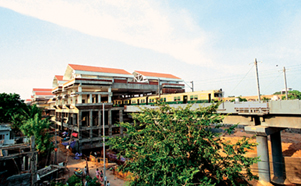|
Will the MRTS accept the suggestions of students of architecture to breathe new life into the ghostly shells that are its stations? We will know next March when a symposium is held on what the students have developed between now and then, working under the guidance of a Professor of the Institute of Engineering, Berlin.
Prof. Gunter Nest’s month-long workshop on ‘Chennai: Human Space – Cultural Space’, which was inaugurated recently at the School of Architecture and Planning, Anna University, is the first step towards this. During the workshop, students of the Department of Architecture will discuss what can be done to bring vibrancy and life to 18 MRTS stations that, today, are huge empty spaces with little life in them. After the workshop, the students will prepare competitive designs to make these stations ‘human spaces – cultural spaces’ and the best designs will be discussed at the symposium after which they will be offered to the MRTS to take them further. Whether it will do so or not is altogether a different question, but the project by then might well have instilled in the students a sensitivity towards creating spaces that are human spaces, spaces that throb with life.

A MRTS station.
|
One of the thoughts that cropped up while conceiving the project was to link a particular station with a major institution / activity not far from it and develop the station as a mirror of sorts of its neighbour. For instance, the Chepauk Station, next to Chepauk Stadium, could focus on cricket, with a cricket museum, a bookstore focussed on sport, and a cricket café. The Triplicane Station next to Presidency College could reflect the City’s educational heritage, and the Chintadripet Station could do the same for the city’s textiles heritage. These ghostly stations we now have must be made places full of life beyond arrivals and departures; they’re so big, they can serve several purposes, not the least as platforms for cultural and recreational activities, this correspondent was told at the inauguration.
As a project, it is a most commendable one. Making ghostly stations cultural and recreational spaces is a great idea. But the project needs to go beyond the discipline of architecture and get other disciplines involved if it is to succeed, because if the ideas of the student-designers are ‘bought’ and implemented, other issues will have to be addressed. First and foremost is the perennial one that’s still to come to pass, namely easy interconnectivity between all the different forms of public transport in the city. And, secondly, sustainability; how will regular maintenance be ensured and by whom? Issues like these need to be thought about long before the symposium.
The project is a joint effort of SAP, Anna University, and the Max Mueller Bhavan/ Goethe Institut, Chennai, and is a part of the year-long Indo-German celebrations that have just got underway to mark sixty years of Indo-German relations that were, with the first exchange of ambassadors, forged in a world recovering from World War II.
|